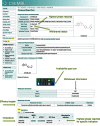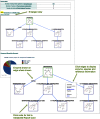The ChEMBL database in 2017
- PMID: 27899562
- PMCID: PMC5210557
- DOI: 10.1093/nar/gkw1074
The ChEMBL database in 2017
Abstract
ChEMBL is an open large-scale bioactivity database (https://www.ebi.ac.uk/chembl), previously described in the 2012 and 2014 Nucleic Acids Research Database Issues. Since then, alongside the continued extraction of data from the medicinal chemistry literature, new sources of bioactivity data have also been added to the database. These include: deposited data sets from neglected disease screening; crop protection data; drug metabolism and disposition data and bioactivity data from patents. A number of improvements and new features have also been incorporated. These include the annotation of assays and targets using ontologies, the inclusion of targets and indications for clinical candidates, addition of metabolic pathways for drugs and calculation of structural alerts. The ChEMBL data can be accessed via a web-interface, RDF distribution, data downloads and RESTful web-services.
© The Author(s) 2016. Published by Oxford University Press on behalf of Nucleic Acids Research.
Figures



References
-
- Arrowsmith J., Miller P. Trial watch: phase II and phase III attrition rates 2011-2012. Nat. Rev. Drug Discov. 2013;12:569. - PubMed
-
- Bunnage M.E. Getting pharmaceutical R&D back on target. Nat. Chem. Biol. 2011;7:335–339. - PubMed
-
- Hay M., Thomas D.W., Craighead J.L., Economides C., Rosenthal J. Clinical development success rates for investigational drugs. Nat. Biotechnol. 2014;32:40–51. - PubMed
Publication types
MeSH terms
Grants and funding
LinkOut - more resources
Full Text Sources
Other Literature Sources
Molecular Biology Databases

